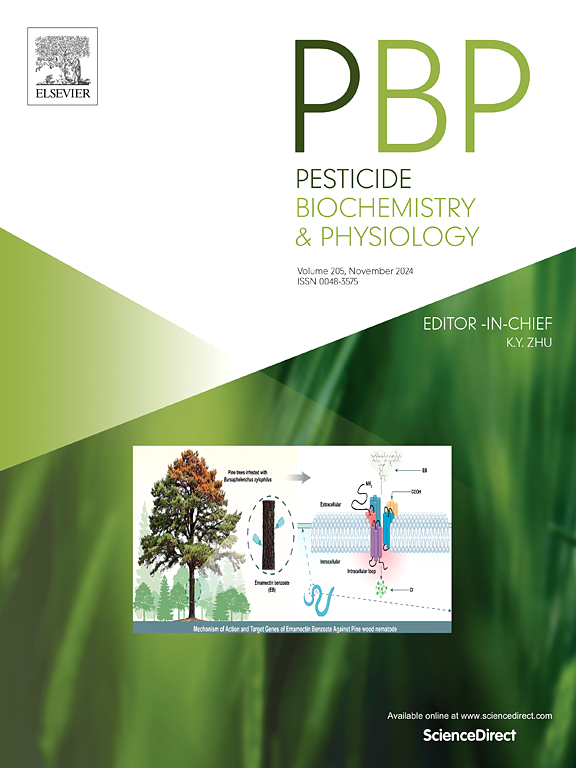Glyphosate combined with TBBPA exposure decreased quality and flavor of common carp (Cyprinus carpio) involved inhibiting muscle growth and collagen synthesis
IF 4.2
1区 农林科学
Q2 BIOCHEMISTRY & MOLECULAR BIOLOGY
引用次数: 0
Abstract
Glyphosate (N-[phosphonomethyl] glycine, GLY) is the active ingredient of the most widely used commercialized herbicide, and its use increases the potential for co-occurrence with flame retardants such as Tetrabromobisphenol A (TBBPA), posing a threat to aquatic systems and food safety. Therefore, it is important to prioritize evaluating these two compounds' combined toxicity. However, only a few studies have analyzed the effects of pollutant mixing on fish from the perspectives of molecular and nutritional components. In this study, the impact of TBBPA and GLY on muscle development and flesh quality was investigated by exposing common carp to water-borne TBBPA and/or GLY for 30 days. The results showed that TBBPA and GLY exposure decreased the anti-oxidant capacity and content of most free amino acids in common carp muscle. Textural analysis suggested that the meat flesh's hardness, cohesiveness, and chewiness were decreased under TBBPA and GLY exposure. In addition, the decreased cross-sectional area of muscle fibers and collagen deposition were observed in the carp muscle exposed to TBBPA and/or GLY. Further analysis of related genes indicated the co-exposure of TBBPA and GLY significantly upregulated the levels of FoxO1 and MuRF-1, and decreased the levels of MyoD1, Collagen I, α-SMA, and TGF-β. Collectively, our results illustrated that exposure to TBBPA and GLY could inhibit muscle growth and decrease nutritional value in common carp.

草甘膦与TBBPA联合暴露会降低鲤鱼的品质和风味,这与抑制肌肉生长和胶原蛋白合成有关
草甘膦(N-[磷甲乙基]甘氨酸,GLY)是使用最广泛的商业化除草剂的活性成分,它的使用增加了与四溴双酚A (TBBPA)等阻燃剂共发生的可能性,对水生系统和食品安全构成威胁。因此,优先评价这两种化合物的联合毒性是很重要的。然而,从分子和营养成分的角度分析污染物混合对鱼类的影响的研究很少。本研究通过将普通鲤鱼暴露于水中TBBPA和/或GLY中30天,研究了TBBPA和GLY对肌肉发育和肉质的影响。结果表明,TBBPA和GLY暴露降低了鲤鱼肌肉的抗氧化能力和大部分游离氨基酸的含量。质构分析表明,TBBPA和GLY处理降低了肉质的硬度、黏结性和咀嚼性。此外,暴露于TBBPA和/或GLY的鲤鱼肌肉的肌纤维横截面积减少,胶原沉积减少。进一步的相关基因分析表明,TBBPA和GLY共暴露可显著上调FoxO1和MuRF-1水平,降低MyoD1、Collagen I、α-SMA和TGF-β水平。总之,我们的研究结果表明,暴露于TBBPA和GLY会抑制普通鲤鱼的肌肉生长,降低营养价值。
本文章由计算机程序翻译,如有差异,请以英文原文为准。
求助全文
约1分钟内获得全文
求助全文
来源期刊
CiteScore
7.00
自引率
8.50%
发文量
238
审稿时长
4.2 months
期刊介绍:
Pesticide Biochemistry and Physiology publishes original scientific articles pertaining to the mode of action of plant protection agents such as insecticides, fungicides, herbicides, and similar compounds, including nonlethal pest control agents, biosynthesis of pheromones, hormones, and plant resistance agents. Manuscripts may include a biochemical, physiological, or molecular study for an understanding of comparative toxicology or selective toxicity of both target and nontarget organisms. Particular interest will be given to studies on the molecular biology of pest control, toxicology, and pesticide resistance.
Research Areas Emphasized Include the Biochemistry and Physiology of:
• Comparative toxicity
• Mode of action
• Pathophysiology
• Plant growth regulators
• Resistance
• Other effects of pesticides on both parasites and hosts.

 求助内容:
求助内容: 应助结果提醒方式:
应助结果提醒方式:


